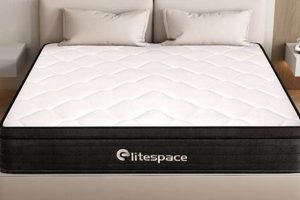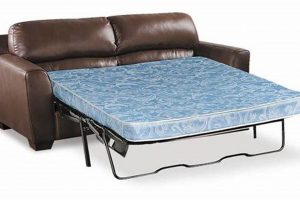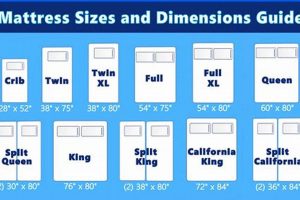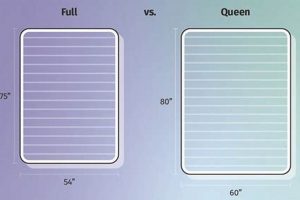The dimensions of a standard double bed typically measure 54 inches in width and 75 inches in length. This surface area provides adequate space for a single sleeper to move comfortably, or it can accommodate two adults in a more compact arrangement. For instance, a growing teenager transitioning from a twin bed might find this option suitable, as would a couple residing in a smaller apartment where space is a premium.
Choosing the correct bed dimensions is crucial for ensuring restful sleep and optimizing room layout. A properly sized sleeping surface contributes to better sleep quality by allowing sufficient personal space. Historically, the selection of bed sizes has evolved to meet changing lifestyle needs and living space constraints, with the double bed offering a balance between affordability and spaciousness. Its ubiquity stems from its ability to satisfy a range of requirements for different individuals and households.
Therefore, understanding the measurement parameters and implications of bed dimensions is essential when furnishing a bedroom. The following discussion will delve into related topics, including comparisons with other bed sizes, considerations for bedroom size, and factors to consider when purchasing bedding accessories.
Selecting a Double Bed
Choosing a bed of this specific size requires careful consideration of several factors to ensure optimal comfort and efficient use of space.
Tip 1: Room Dimensions: Measure the bedroom accurately before committing to this bed size. Ensure sufficient clearance for movement around the bed and other furniture. For example, a small room (e.g., 10 feet by 10 feet) may feel cramped with a double bed and additional furniture.
Tip 2: Sleeper Occupancy: Consider the number of individuals who will be using the bed regularly. While suitable for a single person, two adults may find it lacking in personal space, particularly if one or both tend to move considerably during sleep.
Tip 3: Budget Allocation: Factor in the cost of the mattress, bedding, and frame. Double beds typically require specific-sized sheets and blankets, and the price can vary significantly depending on the materials and brand.
Tip 4: Mattress Type: Explore various mattress options, such as innerspring, memory foam, or hybrid models. The choice should align with individual preferences for firmness and support to maximize comfort and sleep quality.
Tip 5: Frame Stability: Invest in a sturdy bed frame designed to support the weight of the mattress and occupants. A poorly constructed frame can lead to premature wear and tear or even structural failure.
Tip 6: Bedding Acquisition: Purchase appropriate bedding sets explicitly designed for these dimensions. Avoid using smaller bedding, which may not provide adequate coverage and could result in discomfort.
Tip 7: Future Planning: Anticipate potential changes in living arrangements. If relocation or expansion of the household is anticipated, consider whether the double bed will continue to meet the evolving needs.
In summary, proper assessment of room size, intended occupancy, budget constraints, mattress type, frame quality, and future needs will contribute significantly to a successful selection.
The subsequent section will address common misconceptions related to beds of this dimension and provide solutions to optimize your purchase.
1. Width
The 54-inch width is a defining characteristic of a full-size mattress. It is a critical dimension determining the overall sleeping area offered by this mattress type. A mattress lacking this specific width cannot be accurately categorized as a full-size, regardless of its length or other features. For instance, if a mattress measures 48 inches in width but maintains a 75-inch length, it deviates significantly from the standard definition and is not interchangeable with a true full-size mattress. This specific measurement directly impacts its suitability for accommodating one or two sleepers, affecting comfort levels and sleep quality.
This standardized width has implications for related purchases, such as bed frames, sheets, and other bedding accessories. Bed frames designed for full-size mattresses are specifically engineered to accommodate this 54-inch width, ensuring proper support and preventing issues like mattress overhang or instability. Similarly, sheet sets labeled as “full-size” are manufactured to fit mattresses of this exact width, providing a snug and secure fit. Deviations from this width can result in incompatibility and functional problems.
Therefore, understanding the 54-inch width as an integral attribute is paramount when selecting a mattress and associated accessories. It provides a clear benchmark for comparison and ensures compatibility across various components. Ignoring this dimensional specification can lead to ill-fitting bedding, unstable support, and ultimately, a compromised sleep experience. Accurate measurement and adherence to this standard are crucial for optimal performance and satisfaction.
2. Length
The dimension of 75 inches in length is a fundamental component defining the full-size mattress category. Without this specific measurement, a mattress cannot be correctly classified as such, irrespective of its width or any other attribute. This length dictates the sleeping area available to the occupant, determining whether an individual can comfortably stretch out without their feet extending beyond the mattress edge. For instance, a taller individual, say someone six feet in height, requires a minimum length of 72 inches for comfortable sleep. A full-size mattress with its 75-inch length provides a reasonable allowance, ensuring adequate support from head to toe. A bed shorter than this, even with an equivalent width, would compromise the sleeper’s comfort.
This specific length specification also directly influences the compatibility of accessories like bed frames and sheets. Bed frames designed for full-size mattresses are precisely engineered to accommodate a 75-inch length, ensuring proper support and preventing issues such as mattress overhang or shifting. Similarly, full-size fitted sheets are cut to fit a mattress of this length, guaranteeing a snug fit and preventing the sheet from riding up during sleep. Purchasing a shorter or longer sheet for a standard full-size mattress would lead to either an inadequate fit or excessive slack, both resulting in discomfort and inconvenience.
In summary, the 75-inch length is not merely an arbitrary measurement; it’s an essential element that defines the practicality and usability of a full-size mattress. Its contribution to the overall sleeping experience, compatibility with related accessories, and suitability for various body types underscore its significance. Accurate knowledge of this dimension is crucial for making informed purchasing decisions and avoiding potential issues related to comfort and fit. Therefore, a full-size mattress is inherently defined by its 54-inch width and its 75-inch length.
3. Surface Area
The surface area of 4050 square inches is a direct consequence of the specified dimensions of a full-size mattress. Given its width of 54 inches and length of 75 inches, multiplying these values yields this precise surface area. This measurement quantifies the total sleeping space available on the mattress. For instance, consider two individuals sharing a full-size mattress; the 4050 square inches must accommodate both sleepers. If each individual requires at least 2000 square inches for comfortable sleep, this configuration may prove inadequate, potentially leading to restricted movement and disrupted sleep patterns. The relationship is causative, as the physical dimensions directly determine the surface area.
The significance of knowing the surface area lies in its practical application for assessing the suitability of the mattress. A larger surface area typically correlates with increased comfort, particularly for multiple occupants or individuals who prefer ample space to move during sleep. For example, a single individual who frequently sprawls across the bed would benefit from this area. Retailers often use surface area as a comparative metric, allowing consumers to objectively evaluate different mattress sizes. Understanding this relationship enables a more informed decision-making process based on quantifiable data rather than subjective impressions alone. Further, the surface area influences the thermal properties of the sleeping arrangement, impacting heat distribution and breathability, aspects important for restful sleep.
In conclusion, the surface area of 4050 square inches serves as a critical, quantifiable measure derived from the dimensional characteristics of a full-size mattress. Its understanding provides tangible insights into the sleeping space offered, facilitating informed decision-making for potential buyers. While the full-size mattress provides a viable option for certain individuals, assessing the 4050 square inches in relation to personal sleep preferences and occupancy is paramount for ensuring optimal comfort and satisfaction. A challenge lies in visualizing and internalizing this measurement, suggesting a need for more visual aids and comparative tools in the mattress selection process.
4. Suitable for
The designation of suitability for one or two persons is a key consideration when evaluating a full-size mattress. This attribute directly reflects the dimensional properties and intended use-case of the bed, influencing comfort levels and overall satisfaction.
- Individual Sleep Space
A single sleeper will find a full-size mattress provides ample room to stretch and move freely during sleep. The dimensions offer a significant upgrade from a twin bed, allowing for greater personal space and minimizing the feeling of confinement. This can be especially beneficial for those who tend to toss and turn or prefer to sleep in various positions. However, the suitability depends on the individual’s size and sleep habits.
- Occupancy Dynamics
When shared by two individuals, a full-size mattress offers a more intimate sleeping arrangement. While feasible for couples, it may not provide sufficient personal space for undisturbed sleep, particularly if one or both individuals are restless sleepers. Consider a queen or king-size mattress for enhanced individual comfort when accommodating two occupants.
- Room Size Considerations
The recommendation of “Suitable for: One/Two persons” is interlinked with room dimensions. The mattress will fit in smaller rooms while offering considerable space. This dual-occupancy may be better suited to situations where bedroom space is at a premium, such as small apartments or guest rooms, but individual sleep preferences are less prioritized.
- Cost Efficiency
It might seem counter-intuitive to consider full size for one person. However, if space is not an issue, some single sleepers opt for a larger, full size to maximize comfort. Cost is an essential point in a full-size mattress. While queen and king sizes may be suitable for two people, full-size mattresses present an affordable sleeping arrangement to those that are cost-sensitive.
In summary, the determination of suitability for one or two persons is a crucial factor to consider when evaluating a full-size mattress. This depends on considerations of space and costs. Balancing these factors will ensure the purchase of the appropriate size.
5. Room Size
The designation of a full-size mattress as being appropriate for medium to larger rooms highlights a critical aspect of bedroom planning. This consideration emphasizes the interplay between furniture dimensions and available space, influencing both aesthetics and functionality.
- Spatial Harmony
A full-size mattress, while smaller than queen or king options, still requires sufficient surrounding space to maintain visual balance and ease of movement. Cramping a full-size bed into a small room can lead to a cluttered and claustrophobic environment, hindering the room’s usability. A medium to larger room provides the necessary buffer, allowing for comfortable navigation and the inclusion of additional furniture pieces without overwhelming the space.
- Furniture Integration
Bedroom design frequently incorporates items beyond the bed, such as nightstands, dressers, and seating. The “Medium/Larger” room size recommendation accounts for the inclusion of these elements. Attempting to fit a full-size bed alongside standard bedroom furniture in a small room often results in compromised access and a cramped layout. A larger space permits a more balanced arrangement, optimizing both form and function.
- Aesthetic Considerations
Beyond practical functionality, room size impacts the overall aesthetic appeal of the bedroom. A full-size bed placed in a room deemed too small can appear disproportionately large, disrupting the visual harmony. Conversely, in a medium to larger room, the same bed presents a more balanced and intentional design choice. The space allows for the use of visual cues, such as rugs and artwork, to further enhance the room’s aesthetic qualities.
- Ergonomic Accessibility
The relationship between bed size and room size directly impacts the ease of use and accessibility. Navigating around a bed in a confined space can be challenging, especially for individuals with mobility issues. The recommendation for “Medium/Larger” rooms acknowledges the importance of providing ample clearance around the bed, ensuring safe and comfortable access. This consideration is particularly relevant for older adults or those with physical limitations.
Therefore, the association of a full-size mattress with medium to larger rooms underscores the importance of spatial planning. While the bed itself may be a suitable size for individual needs, the surrounding environment must also be considered to ensure functionality, visual harmony, and ergonomic accessibility. Disregarding this guidance can lead to compromised comfort and an aesthetically unpleasing living space. The balance between mattress size and room size is paramount.
6. Bedding
The widespread availability of bedding for a full-size mattress is a significant practical advantage for consumers. This accessibility streamlines the purchasing process and contributes to the overall convenience of owning a bed of this specific dimension.
- Standardized Sizing
The consistent dimensions of full-size mattresses have facilitated the establishment of standardized bedding sizes. This standardization ensures that sheets, comforters, and other bedding accessories labeled as “full-size” will generally fit mattresses conforming to the 54-inch by 75-inch specification. For example, retail outlets commonly stock full-size sheet sets from various manufacturers, minimizing the risk of purchasing ill-fitting products. This uniformity is a direct benefit of adherence to the established standards for full-size mattresses.
- Broad Retail Availability
The prevalence of full-size mattresses has incentivized retailers to maintain extensive inventories of corresponding bedding. Major department stores, online retailers, and specialty bedding shops typically offer a wide selection of full-size sheets, blankets, duvet covers, and other accessories. This widespread availability reduces the time and effort required to locate appropriate bedding. A consumer furnishing a guest room, for instance, can readily find a complete bedding ensemble in the desired style and material.
- Competitive Pricing
The high demand for full-size bedding fosters competition among manufacturers and retailers, resulting in competitive pricing. Consumers benefit from a range of options at various price points, allowing them to select bedding that aligns with their budget. For example, economical microfiber sheet sets and premium Egyptian cotton options are both typically available in full-size, catering to diverse consumer preferences and financial constraints.
- Variety of Styles and Materials
Due to their widespread appeal, bedding for full-size mattresses is manufactured in a wide variety of styles, materials, and designs. Whether a consumer seeks percale cotton sheets, flannel bedding for winter, or a decorative comforter set, the market generally offers an extensive range of choices. This diversity enables consumers to personalize their sleeping environment and express their individual aesthetic preferences.
In summary, the ease of obtaining bedding for a full-size mattress is a substantial benefit, stemming from standardized sizing, broad retail availability, competitive pricing, and diverse style options. This accessibility streamlines the purchasing process and enhances the overall ownership experience for individuals who select this common mattress size.
7. Alternative
The selection of a full-size mattress often prompts consideration of its dimensional alternative: the queen mattress. The queen mattress occupies a distinct position within the spectrum of mattress sizes, presenting a larger surface area and altered proportions that cater to specific needs and preferences.
- Increased Width and Occupancy
A primary differentiator is the augmented width of a queen mattress, typically measuring 60 inches compared to the full-size’s 54 inches. This increase of six inches translates directly into enhanced personal space, particularly relevant for couples. While a full-size may suffice for two occupants, the limited width often compromises sleep quality due to constrained movement. The additional space offered by a queen mitigates this issue, promoting more restful sleep for both individuals.
- Extended Length and Height Accommodation
Standard queen mattresses often match or exceed the length of full mattresses. This dimension is important for people with taller heights. Therefore, it is appropriate to evaluate length and height before committing to the mattress, given that it is a key factor in sleep quality.
- Room Size Implications
The larger footprint of a queen mattress necessitates a correspondingly larger bedroom. Placement in a smaller room can result in spatial constraints, limiting movement and impacting the overall functionality of the room. The decision to opt for a queen over a full-size must consider the room’s dimensions and the presence of other furniture. While a full-size offers spatial efficiency, the comfort trade-off warrants careful evaluation.
- Cost and Accessory Considerations
Queen mattresses and their accompanying accessories (sheets, frames, etc.) typically command a higher price point than their full-size counterparts. This cost differential must be factored into the purchasing decision. Additionally, the specific dimensions of a queen necessitate appropriately sized bedding, adding to the overall expense. The prospective buyer must weigh the benefits of increased space against the financial implications of selecting a queen over a full-size.
In summary, the queen mattress presents a viable alternative to the full-size, characterized by increased dimensions and corresponding implications for occupancy, room size, and cost. The suitability of either option hinges upon a comprehensive assessment of individual needs, spatial constraints, and budgetary considerations.
Frequently Asked Questions
The following section addresses common inquiries regarding the size specifications of mattresses, providing clarity on key dimensions and related considerations.
Question 1: What are the exact dimensions of a standard double bed?
A standard double bed measures 54 inches in width and 75 inches in length. These dimensions are consistent across most manufacturers and are crucial for selecting appropriate bedding and bed frames.
Question 2: Is a double bed suitable for two adults?
While a double bed can accommodate two adults, it may be more suitable for individuals who prefer a more intimate sleeping arrangement or have limited space. A queen or king-size bed generally provides greater individual sleeping space.
Question 3: How does a double bed compare to a queen bed in terms of size?
A queen bed is larger than a double bed, measuring 60 inches in width and 80 inches in length. This additional width and length offer increased comfort, particularly for couples or taller individuals.
Question 4: What room size is recommended for a double bed?
A medium to larger-sized room is recommended for a double bed. This ensures sufficient space for movement around the bed and the inclusion of other furniture without overcrowding the room.
Question 5: Are bedding and accessories readily available for double beds?
Yes, bedding and accessories are widely available for double beds due to their standardized dimensions. Major retailers and online stores typically offer a variety of sheets, comforters, and bed frames designed specifically for double beds.
Question 6: Can a double bed frame accommodate a mattress of a different size?
No, a double bed frame is designed to fit a mattress with the exact dimensions of 54 inches by 75 inches. Attempting to use a mattress of a different size can result in instability and potential damage to the frame or mattress.
In summary, understanding the dimensions of a double bed is crucial for making informed purchasing decisions and ensuring optimal comfort and functionality. These FAQs provide a comprehensive overview of key considerations related to double bed sizes.
The next section will offer guidance on selecting the ideal mattress type based on individual sleep preferences and needs.
Determining the Dimensions of a Standard Double Bed
This exposition has systematically detailed the dimensional properties inherent to a standard double bed, frequently referenced as “what size is full size mattress.” The investigation has established that a full-size mattress consistently measures 54 inches in width and 75 inches in length. These dimensions dictate the surface area, occupancy suitability, room size compatibility, and bedding availability associated with this particular mattress type. Moreover, the analysis has compared and contrasted the characteristics of a full-size mattress with those of a queen mattress, thereby furnishing a comprehensive understanding of alternative options.
The accurate comprehension of dimensional specifications is paramount for informed consumer decision-making within the bedding industry. It is incumbent upon prospective purchasers to meticulously evaluate their individual needs and spatial constraints prior to committing to a specific mattress size. Ignoring these critical considerations can lead to compromised comfort, inadequate functionality, and ultimately, buyer dissatisfaction. Therefore, due diligence is strongly encouraged when selecting a sleep surface.







